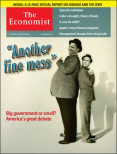When Did The Economist Become Comically Stupid?
By James Kwak
I recently got around to looking at my latest issue of The Economist. Here’s the cover:
If you can’t make it out, that’s a huge Barack Obama, a small Mitt Romney, and the following caption: “Big government or small? America’s great debate.”
Now, how you could draw a contrast between two men who passed structurally identical health care plans—in which government regulation is used to incent people to buy insurance from private companies—baffled me. The caption, if anything, should have been “Small government or tiny?” So I peeked inside, where things get worse.
The premise of the article is that President Obama has made government bigger. But there’s no intelligent way to make this case, because it just isn’t true by any meaningful measure. There’s a chart in the print edition (which I can’t find online) showing government employment as a percentage of total employment and as a percentage of the potential labor force (correcting for the overall business cycle). The former line went up from 2007 to 2010 (hey! big government!), but the latter line has only gone down since 2002. In other words, government employment is declining as a share of the working-age population, a point also made by Catherine Rampell earlier. And this isn’t a recent phenomenon: the government’s civilian workforce, which was around 1 percent of the population from the 1950s until the early 1990s, is now down around 0.7 percent (see the BLS, Current Employment Statistics).
There’s another chart that purports to show growth in “federal regulatory employment.” But simply glancing at the components of the columns shows that the big increases have been in the TSA and, more recently, “Other Homeland Security.” If Mitt Romney wants to differentiate himself from Barack Obama by slashing homeland security staffing, then The Economist has a point—but I doubt it.
Some of these points are made in the body of the article itself (I suspect the writer knows more or less what’s going on, and the more egregious flaws are due to the editors) , but the only logical conclusion of those caveats is that the article should not have been written in the first place, let alone splashed with a silly graphic on the cover. The only thing the article’s author argues is a meaningful increase in the “size” of government is an increase in regulatory policy-making, notably by the EPA, the Affordable Care Act, and the financial regulatory agencies. But the EPA is only more active by comparison to the George W. Bush years, when the agency was under pressure not to do anything; the Affordable Care Act, as mentioned above, is modeled on Romneycare (which we are pretty happy with here in Massachusetts); and who would argue with a straight face that the laissez-faire financial regulation of the pre-crisis years was a good thing?
It is a major problem that many people do not really understand what the federal government does, let alone whether it is growing or shrinking. (Chapter 4 of White House Burning attempts to clear up these questions.) A goofy Photoshop montage portraying President Obama as a booster of big government only reinforces people’s misconceptions.



Simon Johnson's Blog
- Simon Johnson's profile
- 78 followers




